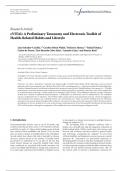Tentamen (uitwerkingen)
eVITAL: APreliminaryTaxonomyandElectronicToolkitof Health-Related Habits and Lifestyle
- Instelling
- CAH Almere (CAH)
Research Article The cientificWorldJOURNAL eVITAL: APreliminaryTaxonomyandElectronicToolkitof Health-Related Habits and Lifestyle Luis Salvador-Carulla,1,2 Carolyn Olson Walsh,3 Federico Alonso,1,2 Rafael G´omez,1 Carlos de Teresa,1 Jos´ e Ricardo Cabo-Soler,1 Antonio Cano,1 and Menc´ ...
[Meer zien]




